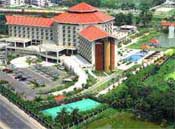 The Nepali government has brought new tourism policy to promote tourism industry, The Himalayan Times reports.
The Nepali government has brought new tourism policy to promote tourism industry, The Himalayan Times reports.
Addressing a press meeting, Minister for Tourism and Civial Aviation Hisila Yami said the ministry is planning a curriculum regarding tourism and the development of a separate Tourism University.
“European arrivals are declining due to the global financial crisis as they are investing in short distance tourist destinations,” she said, adding that the focus of Nepal will now be on boosting regional tourism.
“The new policy will also promote rural, agro, adventure, health and educational tourism,” Yami said. The ministry is planning to include tourism industry in Special Economic Zones.
The government is planning to construct a second international airport in Nijgadh of Bara district in central Nepal to avoid congestion. “Korean company LMW has shown interest in the construction of a second international airport and submitted a proposal that is under consideration,” Yami said.
“To provide air services to people in rural areas also, single-engine aircraft, cargo and air taxis will soon become operational and that will reduce airfare by 25 percent in the Karnali and western regions,” said Yami.
The ministry is also reviewing the Air Service Agreements (ASAs) with India and Qatar. “The ASAs with Bahrain and Sri Lanka were reviewed recently,” she said.
“To make Nepal Tourism Year 2011 a grand success, the government has formed 14 different sub-committees along with regional committees,” the minister said, adding that to develop the tourism industry, Nepal Tourism Board, Nepal Airlines Corporation and Hotel Association of Nepal are jointly working on special packages.
There are also some modifications in the civil aviation sector aiming at reducing air congestion.” We are planning separate parking places for helicopters and Twin Otters,” said Yami.
According to the daily, the Nepali government will provide 10 Nepali rupees (0.125 U.S. dollar) subsidy on diesel and has withdrawn electricity demand charge for hotels, just like manufacturing industries.
After posting hopeful growth of 26 and 12 percent in January and February, respectively, tourist arrivals via air in March fell into single digit growth. Arrivals in March grew by just 4.6 percent due to decline in arrivals from Europe.
Nepal Tourism Board (NTB)’s statistics show growth in tourist arrivals slowed down in the first three months (January-March) of 2011 compared to the same period in 2010. According to NTB, arrivals grew by 12.5 percent in the first three months of 2011, while the growth during the same period last year was at 29.78 percent.
The Nepal Tourism Year has targeted 700,000 tourists and March is considered one of the prime tourist seasons. European arrivals posted a negative growth of 12.6 percent in March. Arrivals from the major European markets such as the UK, Germany, the Netherlands, Spain and Switzerland registered negative growth of 27 percent, 16.1 percent, 20.3 percent, 43 percent and 7.7 percent, respectively.
Travel trade entrepreneurs are surprised by the decline in European arrivals. “We are also surprised why the European market is declining,” said Ashok Pokharel, president of the Nepal Association of Tour Operators (NATO). He added that there was a need to think seriously about the downturn in the European market which is a source of high-end travellers. Some entrepreneurs attribute this decline to increase in international airfares catalysed by rising aviation fuel price. “The major reason behind the decline in the number of European tourists is a hike in airfares with the price of aviation fuel rising continuously in the global market,” said Rajendra Bajgai, general secretary of the Trekking Agencies Association of Nepal (TAAN). “Coming to Nepal from Europe without direct connectivity is very expensive.”
Gandaki Tours and Travels Managing Director Ram Kazi Koney agrees with Bajgai. Koney said lack of direct flights between Nepal and Europe is one of the reasons behind the slump. “Moreover, promotion and marketing of Nepal Tourism Year-2011 has not been carried out in Europe, and this has also affected growth in the Europe segment,” Koney added.
The International Air Transport Association (IATA) has warned that fuel prices could increase and the global aviation industry will face a setback. In addition, Japan produces 3-4 percent of the global jet fuel supply, some of which is exported to Asia. Some of this refinery has been lost due to damages caused by the earthquake. This supply restriction could lead to higher jet fuel prices. “Airfares are rising already with numbers of international airlines increasing fuel surcharges because costs for fuel increased drastically,” said IATA.
India, which is the major market for Nepal, recorded a growth of 28 percent while Sri Lanka and Pakistan posted a growth of 38.3 percent and 6.8 percent respectively. However, arrivals from Bangladesh declined by 2.5 percent. The South Asian segment registered a growth of 22.5 percent. Arrivals from Asia other than South Asia also recorded a growth of 15.1 percent. Arrivals from China and Japan increased 15.2 percent and 9.6 percent respectively. Similarly, arrivals from South Korea, Thailand, Malaysia and Singapore increased by 12.1 percent, 51.9 percent, 16.2 percent and 10.8 percent respectively. Tourist arrivals from the US increased 22.7 percent while arrivals from Australia, New Zealand and Canada saw a negative growth of 3.7 percent, 13.5 percent and 5.3 percent respectively.
Meanwhile, the Nepali government has brought new tourism policy to promote tourism industry,
Addressing a press meeting, Minister for Tourism and Civial Aviation Hisila Yami said the ministry is planning a curriculum regarding tourism and the development of a separate Tourism University.
“European arrivals are declining due to the global financial crisis as they are investing in short distance tourist destinations,” she said, adding that the focus of Nepal will now be on boosting regional tourism.
“The new policy will also promote rural, agro, adventure, health and educational tourism,” Yami said. The ministry is planning to include tourism industry in Special Economic Zones.
The government is planning to construct a second international airport in Nijgadh of Bara district in central Nepal to avoid congestion. “Korean company LMW has shown interest in the construction of a second international airport and submitted a proposal that is under consideration,” Yami said.
“To provide air services to people in rural areas also, single-engine aircraft, cargo and air taxis will soon become operational and that will reduce airfare by 25 percent in the Karnali and western regions,” said Yami.
The ministry is also reviewing the Air Service Agreements (ASAs) with India and Qatar. “The ASAs with Bahrain and Sri Lanka were reviewed recently,” she said.
“To make Nepal Tourism Year 2011 a grand success, the government has formed 14 different sub-committees along with regional committees,” the minister said, adding that to develop the tourism industry, Nepal Tourism Board, Nepal Airlines Corporation and Hotel Association of Nepal are jointly working on special packages.
There are also some modifications in the civil aviation sector aiming at reducing air congestion.” We are planning separate parking places for helicopters and Twin Otters,” said Yami.
According to the daily, the Nepali government will provide 10 Nepali rupees (0.125 U.S. dollar) subsidy on diesel and has withdrawn electricity demand charge for hotels, just like manufacturing industries. Source : Internet
Nepal emerges as major destination for Asian tourists
Nepal is becoming a major tourism destination for Asian travelers, local media reported.
The World Bank South Asia Economic Update 2010 reveals that travelers from East Asia made up 26.5 percent of the total tourist arrivals in Nepal, according to The Kathmandu Post daily.
The statistics of the Nepal Tourism Board also reflect a similar trend. Tourist arrivals from China, South Korea and Thailand have been increasing in the past few years.
The number of Chinese arrivals in Nepal has increased by 185.97 percent in the last three years. Around 19,000 Chinese tourists visited Nepal in 2009. In the three years, 2006-2009, tourist arrivals from South Korea, Singapore, Thailand and Malaysia have soared by 68.40 percent, 164.26 percent, 83.48 percent and 46.32 percent respectively.
Travel trade analysts attribute the increment in East Asian arrivals to their rising income levels, desire to visit the birthplace of the Buddha and better air connectivity.
Currently, four Chinese airlines operate flights to Nepal with China Eastern Airlines being the latest entrant last year.
The growth in inbound from East Asia has prompted the concerned stakeholders to pay special attention to the region.
Nepal is expecting 100,000 tourists from China during Nepal Tourism Year 2011 while it has targeted a 20 percent increment in tourist arrivals from other Asian countries.
-With xinhuanet.com input

